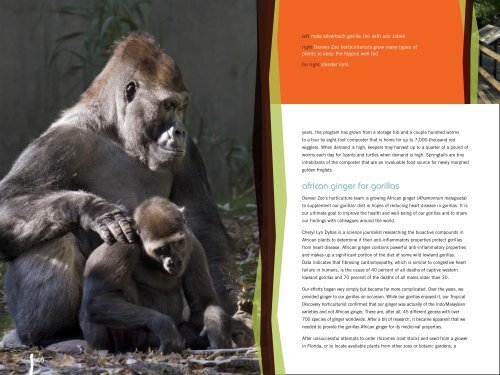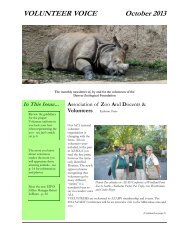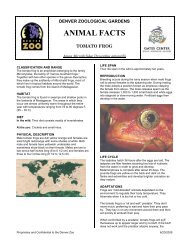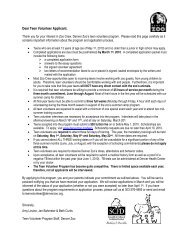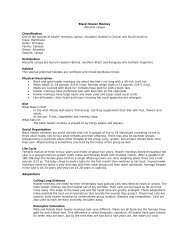2008 Annual Report - Denver Zoo
2008 Annual Report - Denver Zoo
2008 Annual Report - Denver Zoo
- No tags were found...
You also want an ePaper? Increase the reach of your titles
YUMPU automatically turns print PDFs into web optimized ePapers that Google loves.
left male silverback gorilla Jim with son Jabaliright <strong>Denver</strong> <strong>Zoo</strong> horticulturists grow many types ofplants to keep the hippos well fedfar right slender lorisyears, the program has grown from a storage tub and a couple hundred wormsto a four by eight-foot composter that is home for up to 7,000 thousand redwigglers. When demand is high, keepers may harvest up to a quarter of a pound ofworms each day for lizards and turtles when demand is high. Springtails are tinyinhabitants of the composter that are an invaluable food source for newly morphedgolden froglets.african ginger for gorillas<strong>Denver</strong> <strong>Zoo</strong>’s horticulture team is growing African ginger (Aframomum melegueta)to supplement our gorillas’ diet in hopes of reducing heart disease in gorillas. It isour ultimate goal to improve the health and well-being of our gorillas and to shareour findings with colleagues around the world.Cheryl Lyn Dybas is a science journalist researching the bioactive compounds inAfrican plants to determine if their anti-inflammatory properties protect gorillasfrom heart disease. African ginger contains powerful anti-inflammatory propertiesand makes up a significant portion of the diet of some wild lowland gorillas.Data indicates that fibrosing cardiomyopathy, which is similar to congestive heartfailure in humans, is the cause of 40 percent of all deaths of captive westernlowland gorillas and 70 percent of the deaths of all males older than 30.Our efforts began very simply but became far more complicated. Over the years, weprovided ginger to our gorillas on occasion. While our gorillas enjoyed it, our TropicalDiscovery horticulturist confirmed that our ginger was actually of the Indo/Malaysianvarieties and not African ginger. There are, after all, 45 different genera with over700 species of ginger worldwide. After a bit of research, it became apparent that weneeded to provide the gorillas African ginger for its medicinal properties.After unsuccessful attempts to order rhizomes (root stock) and seed from a growerin Florida, or to locate available plants from other zoos or botanic gardens, a40


